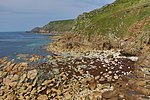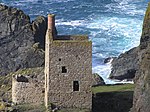Priest Cove
Beaches of PenwithCoves of CornwallPenwith geography stubsPorts and harbours of CornwallSt Just in Penwith ... and 1 more
Use British English from February 2018

Priest Cove (Cornish: Porth Ust, meaning St Just's Cove) or Priest's Cove is a small cove one mile (1.6 km) west of St Just, Cornwall, UK. The name is from the Cornish Porth Ust, the port or cove of St Just, which was shortened to Por’ Ust. The apostrophised name "Priest’s" is a spelling mistake and the site has no connection with the clergy.
Excerpt from the Wikipedia article Priest Cove (License: CC BY-SA 3.0, Authors, Images).Priest Cove
Carn Gloose Road,
Geographical coordinates (GPS) Address Nearby Places Show on map
Geographical coordinates (GPS)
| Latitude | Longitude |
|---|---|
| N 50.125 ° | E -5.706 ° |
Address
Carn Gloose Road
TR19 7NL
England, United Kingdom
Open on Google Maps










